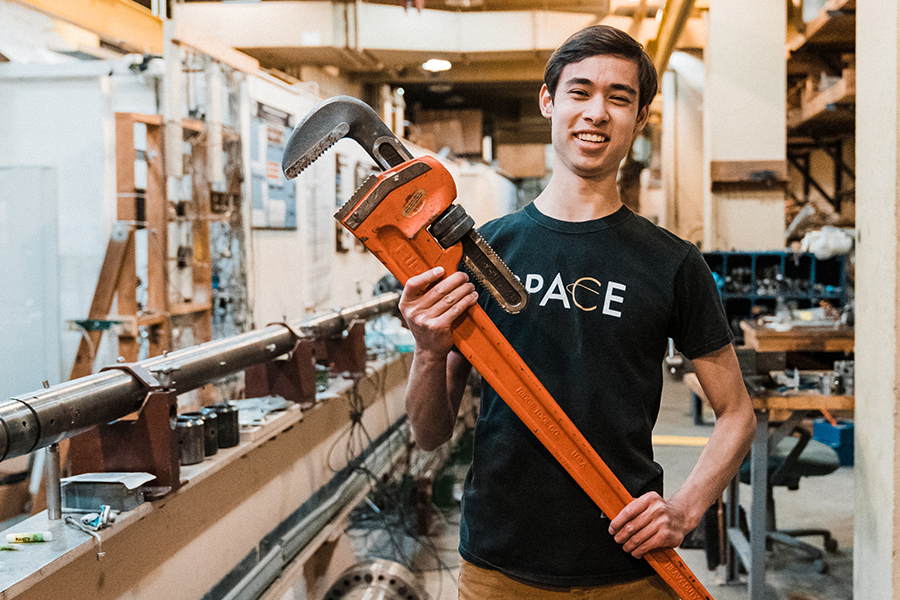Undergraduate Student
How did you become interested in engineering and of UW A&A in particular? Tell us more about your pathways leading you here.
I’ve been interested in aerospace for as long as I can remember. My path included many trips to UW’s annual Engineering Discovery Days event, as well as the Museum of Flight, just south of Seattle. My fascination with flight and spaceflight only continued to grow with time, so when I came to the University of Washington and found the A&A department offered the opportunity to contribute to the cutting edge of human exploration, it was a natural fit.
Tell us about your interesting internships, activities and research lab experience.
While my interests have been relatively constant, my path hasn’t always been linear. At the advice of my parents, I didn’t take on any technical extracurriculars in my freshman year in order to relax and get used to the university environment. At the start of my sophomore year, I began seeking out research opportunities, and found that my Physics 123 professor Dr. Shih-Chieh Hsu was looking for undergraduates to join his particle physics research group. I didn’t know anything about particle physics at the time, but it turns out it involves complex mathematics, statistics, a boatload of programming, and simulation development! While my research wasn’t directly related to any of the opportunities I wanted to pursue in aerospace, it was an absolutely incredible experience. I learned how to program, how to teach, how to collaborate with PhDs and postdocs from around the world, and how to tackle technical topics in which I had no formal background.
During this time, I attended a poster session held by the NASA Washington Space Grant Consortium, where students presented research they had done over the summer on topics in STEM from across the university. A fellow undergrad was presenting her work on the ram accelerator (effectively a hypervelocity space cannon) with Dr. Carl Knowlen in the A&A department, and I was so excited about her presentation that I contacted Dr. Knowlen, and asked to participate in his research group. After a successful interview, I joined my second lab, and began assisting the graduate students in performing tests to explore the system’s operating limits and develop new capabilities in hypervelocity space launch. After a few years, I was running my own experiments, and performing novel, independent research into diffusive fuel/oxidizer mixing in the ram accelerator. I learned about topics such as gas dynamics, combustion, and best practices in high-pressure, high-temperature testing.
During my senior year, I combined the technical skills I developed through my research with the theory I learned from the A&A curriculum, and founded a propulsion research club affiliated with SEDS (the Society for the Exploration and Development of Space). I brought together a group of mentors and students from the Air Force Research Laboratory and the A&A department to design, build, and test a small rocket engine. Building a team from scratch is one of my greatest learning experiences and proudest achievements, and I am incredibly grateful for the support of the department throughout this process. I am hopeful and excited that the project will live beyond my time at UW through the continued efforts of the current club members.
These are just some of the incredible opportunities I’ve had with UW and A&A in particular -- there have been so many I can’t name them all here! Yet as I move on from the University of Washington, and towards an internship at Aerojet Rocketdyne and graduate school at the University of Minnesota where I’ll use computational methods to study hypersonic propulsion, I find that all of these experiences have been essential in shaping who I am, both personally and professionally. At the end of my journey through my bachelor’s degree, I am grateful to A&A for helping me become the engineer I am today.
What do you enjoy most about A&A?
The thing I have enjoyed most, and found most unique about A&A was definitely the people. Many undergraduate engineering degrees offer the opportunity to specialize in designing a particular type of system or interface -- biological, electrical, mechanical. Very few offer the chance to immerse yourself in a topic with such technical depth and incredible visionary breadth as that of flight and spaceflight. The study of aerospace engineering attracts a certain type of person with both passion and technical competence, and in my opinion, the A&A students and faculty are some of the most unique, wonderful, and incredibly capable people you’ll ever have the privilege to meet.
What advice do you have for prospective students?
When I applied to graduate school in the fall of 2021, I asked A&A’s Dr. Marco Salviato for his advice on the subject, and he shared a piece of wisdom his PhD advisor shared with him long ago. I’ll paraphrase here -- in essence, he said being in university is like being lost on a treasure island. You don’t often know where you’re going, and your path may take you to places you never expected. But you are surrounded by such an incredible wealth of knowledge that resides in your peers and your faculty that you should try to take as much as you can before you leave. So before you find your way out of university, stuff your brain with knowledge and seize every opportunity you can, because the experience of university is unlike any other you will ever have. And best of luck on your journey!
